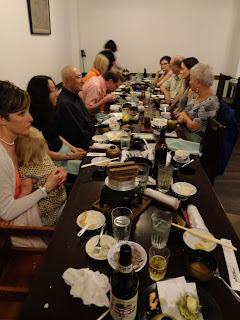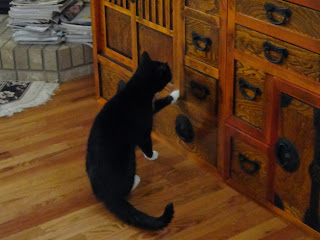“Obachan” died on January 22, 2019 in Seattle. She was a very generous person. She had set aside money for family to attend
her funeral in Hawaii. The ceremony in
Hawaii was really an inurnment. Her
assisted living facility hosted a memorial on January 25.
The memorial followed a “wake” on the evening of the 22nd. The facility allowed the body to remain
overnight (time of death was 9:50 a.m.) and many staff members and residents
dropped in to pay their last respects. Quite
different than most places who want a body removed immediately. Shizuko’s body was cremated on January 24.
We were in Tucson at the time and chose not
to attend that ceremony. Thirteen of us
traveled to Hawaii, arriving on March 9.
That number included children, grandchildren, great grandchildren, and two
nieces.
On Sunday, Michelle’s family took the cremains on a final tour of the
island, including a swap meet. It was a
trip that Obachan made many times as a tour guide for the Japanese.
Monday evening, we boarded a boat
and headed out into the ocean on a “Sunset Cruise” where a package containing
some of the cremains were placed in the sea.
Many years ago, in 1971, we cast a few of Walter’s ashes into the sea,
as he had requested. We were able to do
that from the shoreline in those days.
We were supposed to be three miles out on this occasion, but the captain
fudged quite a bit on that distance because it was a bit rough, and a couple of
us were subject to sea sickness.
The captain shut down the engine, opened the back gate, and the
daughters committed the ashes to the ocean.
We paused long enough to shoot a few more photos, then headed back to
harbor. We
had hopes of seeing a few whales, but that didn’t happen.
It was growing dark as we disembarked.
We travelled to a hotel where Obachan loved to dine. We celebrated her life with a nice meal. We lacked one who retired due to motion
sickness.
The inurnment took place Tuesday March 12, 2019, fifty days after death,
an appropriate interval, I’m told, in the National Memorial Cemetery of the
Pacific, also known as Punchbowl because it is the crater of an extinct
volcano.
If you are a “Hawaii 50” watcher, you
may recognize the monument from the opening shots on that show.
Four or five locals joined the family beneath the small shelter. Following that brief ceremony, we walked some
50 or 60 yards to the gravesite. A two-man
crew from the cemetery, retired servicemen, took over.
They removed a sheet of plywood containing sod from over the grave. They removed a cover from a cement
vault. The clergyman carried the
vase with the ashes from the shelter to the grave site. The three of them
placed the urn into the vault. The crew
did a “Present Arms,” saluted, observed a moment of silence.
Under their direction, we all took a turn at dropping flower petals into
the vault round the urn. When all the
flower petals were in the vault, the crewmen replaced the vault cover. They then used shovels to take soil from
their truck and packed it around and over the vault.
I couldn't keep myself from thinking how much it
was like setting a fence post, with shovels, dirt, and tamping iron. When the soil had been removed from the truck
and placed in the grave, the men took the sod from the plywood and carefully
placed it over the grave. That was
tamped and manicured with soil to fill in the gaps. When they were done, you could not tell there
was ever a disturbance of the earth.
One worker unearthed a flower vase hidden beneath the sod. While he was doing that, his coworker fetched a pitcher of water from a nearby hydrant to fill the vase. The great grandchildren placed some flowers in the vase.
Everyone was invited to attend another meal at a Japanese restaurant. Following the meal, we all disbursed to rest
and recover. Half of the mourners left
on Wednesday. Those headed for Denver
had to alter plans because the snowy cyclone on the planes shut down DIA on
Wednesday. It was tough finding a flight
for Thursday. The last of us left on
Friday, and the funeral was over.
The entire trip, the meals, the ceremony were typical of Obachan’s
generosity. May she be blessed as she
blessed us.
Obituary
At school, Shizuko was the abacus champion and volleyball team captain. She loved to sing and dance. One day, while attending a women’s business
college, her friend convinced her to give her moral support at an audition with
the post-war Ernie Pyle Show which would be performing at the famous Takarazuka
Theatre in the Ginza. On a lark, Shizuko
decided to audition too and was selected to join the troupe.
It was during this time that she met her future husband, Walter
Johnson. They married, had their first
daughter, Patricia, and then decided to move to Honolulu, Hawaii in 1949. Once there, Shizuko began a career as a radio
announcer with KHON and KPOI airing a popular Japanese language children’s
program. They returned to Tokyo in 1954
and had their second daughter, Michelle.
In 1964, the family moved to the United States, first to Denver and then
to Honolulu in 1966. Shizuko soon returned
to her career as a radio announcer, airing a variety music program for KZOO
radio station. She also worked in the
fabric department of the Shirokiya Department Store in Ala Moana Center.
One day a tour company from Japan called Shizuko and asked if she could
take a few visitors around Oahu. She
said “sure!” This simple trip around the
island helped launch the modern Japanese tourism industry in Hawaii. Shizuko worked as a tour guide for several
large Japanese tour companies until she became the first Japanese woman to
obtain a Public Utility Commission license authorizing her to carry passengers
in her spacious green Cadillac. For the
next 40 years, Shizuko owned and operated an independent tour company offering
customized tours to Japanese tourists.
In addition to running her business, Shizuko served as the President of
the Japanese Tour Guide Association for many years.
Shizuko had a great and lasting love for Hawaii, her adopted home for
more than half a century. As often
happens in Hawaii, there came a time when Shizuko had to leave Honolulu to live
closer to her daughters on the mainland.
Shizuko lived her last years at the Nikkei Manor in Seattle, Washington,
making new friends and meeting old fans who had listened to her radio programs
in Hawaii every day! Shizuko’s family is
grateful to the management and staff at Nikkei Manor for the loving, professional
care they provided Shizuko and for making every day for her and for all
residents a joyful experience. Shizuko taught
everyone there how to clap their hands the Japanese way and how to dance the
Tokyo Ondo. She will be remembered for
her engaging smile, her sweet, clear singing voice and her endearing flair for lifting
the spirits of everyone around her.
Shizuko’s husband, Walter, predeceased her. Shizuko is survived by her two daughters,
Patricia and Michelle, four grandchildren, Letitia, LeAndra, Izumi and Seiji
and two great-grandchildren, Bronson and Ealie.
(By Michelle Johnson Hansen)















